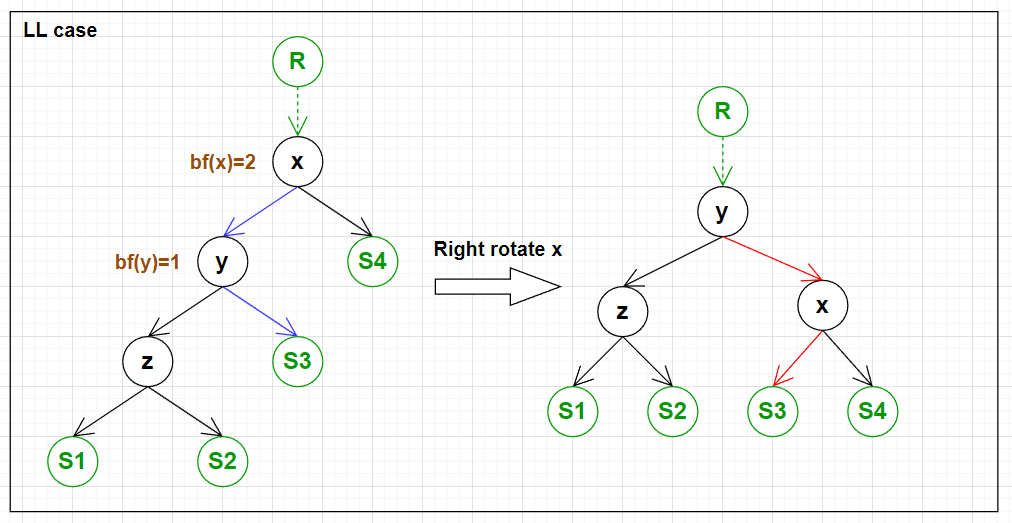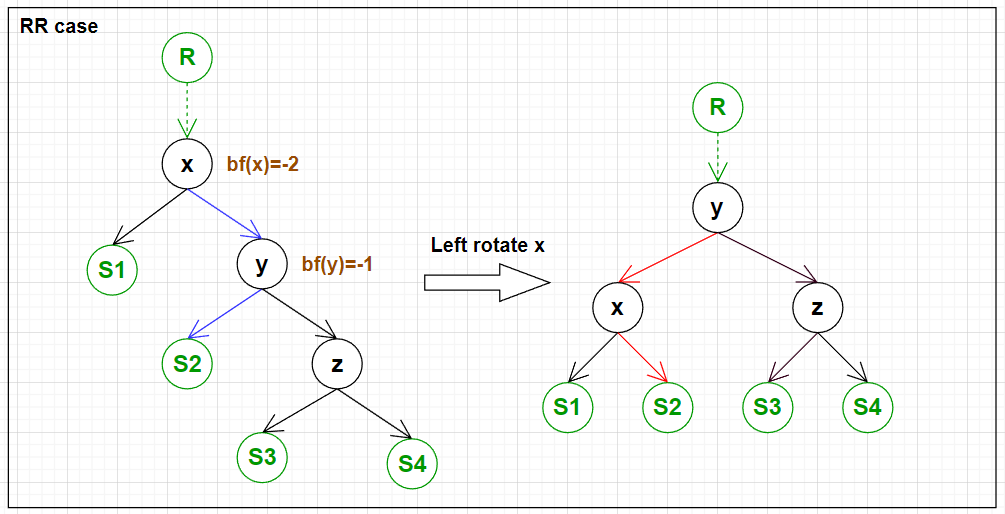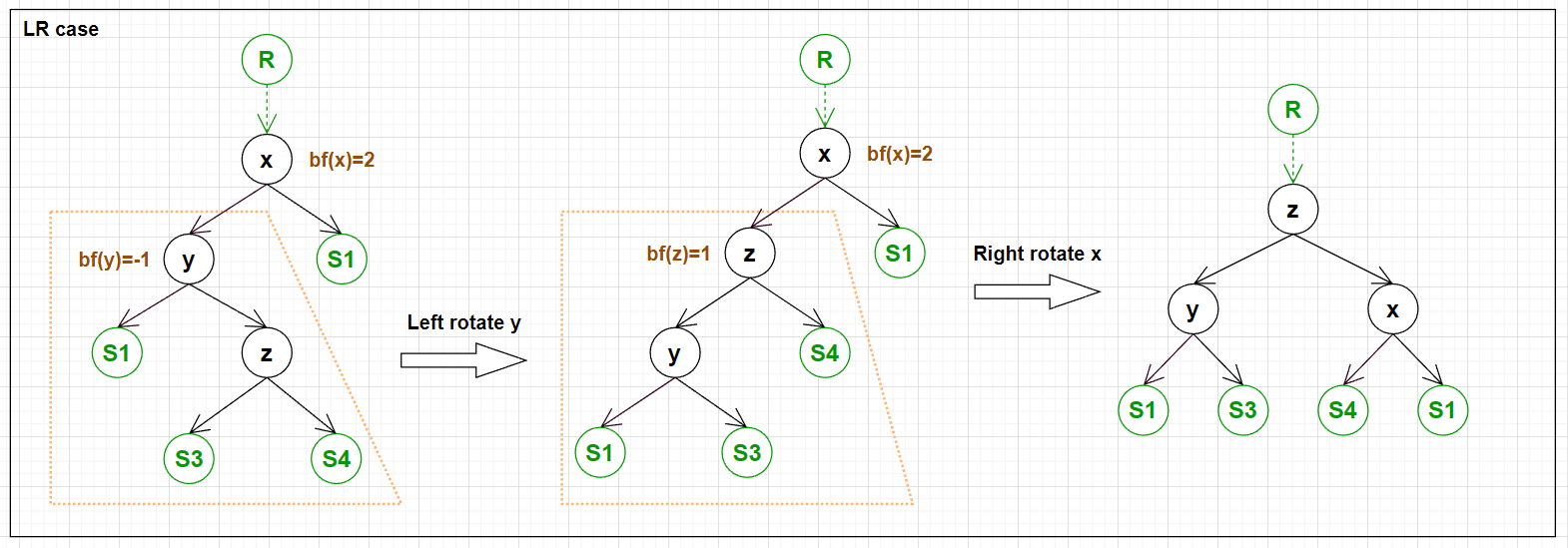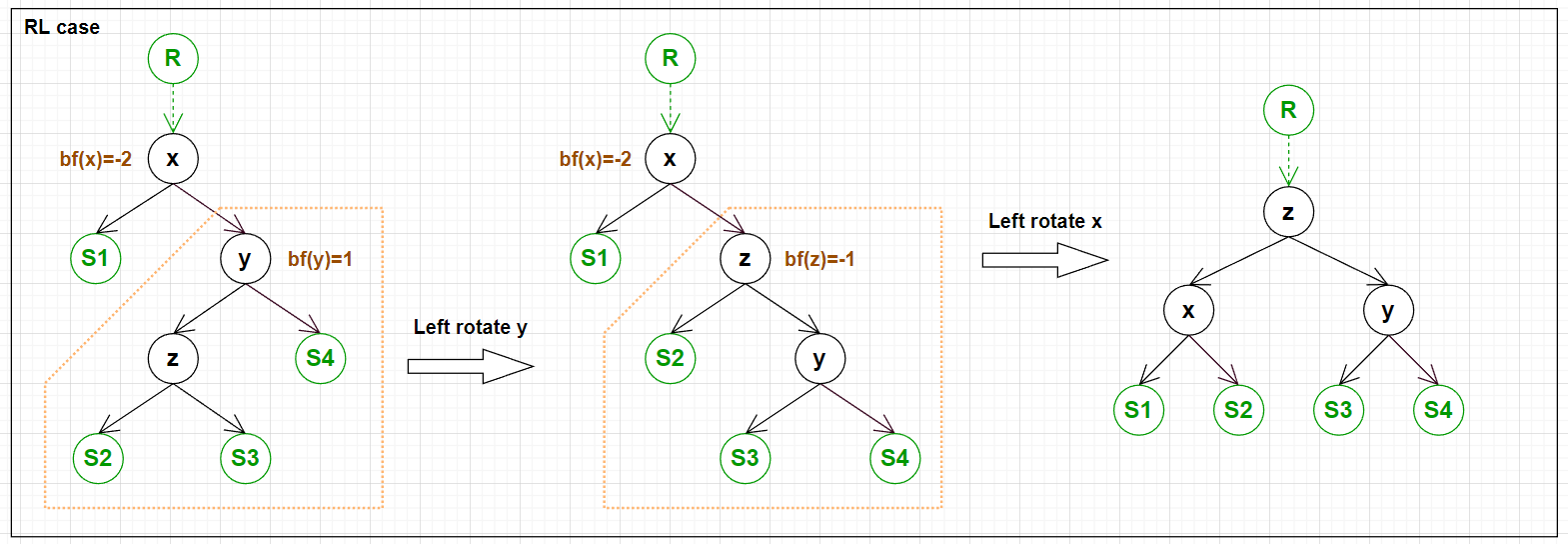AVL Tree (1) - Definition, find and Rotation
1. 定义
- (15-1) [AVL tree]:
- 一棵空二叉树是 AVL tree;
- 若 T 是一棵非空二叉树, 则 T 满足以下两个条件时, T 是一棵 AVL tree:
- T_LeftSubtree 和 T_RightSubtree 是 AVL tree.
- \(| h_{Left} - h_{Right}| \leq 1\).
- [AVL search tree]: AVL tree + binary search tree.
- AVL tree 的高度 \(h=O(\log{n})\)
- [balance foctor] 平衡因子可能取值为
-1,0,1;
对于 nodex, \(bf(x)\) 定义为: \(h_{x\_LeftSubtree} - h_{x\_RightSubtree}\).
AVL Tree 的宗旨在于使 BST 保持平衡, 进而避免 BST 过度倾斜 (极端情况下 BST 有可能成为链表) .
2. btNode 和 AVLTree 的定义
<utility> 头文件提供了 std::pair 的定义, 便于使用融合 key 类型和 value 类型的复合类型.
<iostream> 头文件提供的输出方法由 private method preOrder 使用, 以测试代码正确性.
Click to show the codes
// AVL Tree
#include <utility>
#include <iostream>
/**
* @brief Binary tree node.
* @tparam T Should be std::pair<Key_Type, Element_Type> in binary search tree.
*/
template<class T>
struct btNode
{
T data;
btNode<T>* left, * right;
// Constructor for btNode.
btNode(T d = {}, btNode<T>* l = nullptr, btNode<T>* r = nullptr) :
data(d), left(l), right(r) {}
};
template<class K, class E>
class AVLTree
{
public:
// Constructor for AVLTree.
AVLTree() :root(nullptr) {}
// @brief PreOrder ouput.
void preOrder() { preOrder(this->root); }
public:
// @brief Find the node with key {tKey} and return its address.
btNode<std::pair<K, E>>* find(const K& theKey) const;
// @brief [Iteration] Create a node with {tPair} and insert it to the tree.
void insert_I(const std::pair<K, E>& tPair);
// @brief [Recursion] Create a node with {tPair} and invoke method {m_insert_R}.
void insert_R(const std::pair<K, E>& tPair);
// @brief [Iteration] Erase the node with key {tKey}.
void erase_I(const K& tKey);
// @brief [Recursion] Erase the node with key {tKey}.
void erase_R(const K& tKey);
private: // Rotate methods.
// @brief Right rotate subtree whose root is {tRoot}, return {tRoot->left} as new root.
// e.g. To rotate {parentTarget->left} : parentTarget->left = rightRotate(parentTarget->left)
inline btNode<std::pair<K, E>>* rightRotate(btNode<std::pair<K, E>>* tRoot);
// @brief Left rotate subtree whose root is {tRoot}, return {tRoot->right} as new root.
// e.g. To rotate {parentTarget->left} : parentTarget->left = leftRotate(parentTarget->left);
inline btNode<std::pair<K, E>>* leftRotate(btNode<std::pair<K, E>>* tRoot);
// @brief For LL case, right rotate subtree {tRoot}, return {tRoot->left} as new root.
// e.g. To rotate {parentTarget->left} : parentTarget->left = llRotation(parentTarget->left);
inline btNode<std::pair<K, E>>* llRotation(btNode<std::pair<K, E>>* tRoot);
// @brief For RR case, left rotate subtree {tRoot}, return {tRoot->left} as new root.
// e.g. To rotate {parentTarget->left} : parentTarget->left = rrRotation(parentTarget->left);
inline btNode<std::pair<K, E>>* rrRotation(btNode<std::pair<K, E>>* tRoot);
// @brief For LR case, left rotate {tRoot->left}, right rotate {tRoot}, return {tRoot->left->right}.
// e.g. To rotate {parentTarget->left} : parentTarget->left = lrRotation(parentTarget->left);
inline btNode<std::pair<K, E>>* lrRotation(btNode<std::pair<K, E>>* tRoot);
// @brief For RL case, right rotate {tRoot->right}, left rotate {tRoot}, return {tRoot->right->left}.
// e.g. To rotate {parentTarget->left} : parentTarget->left = rlRotation(parentTarget->left);
inline btNode<std::pair<K, E>>* rlRoattion(btNode<std::pair<K, E>>* tRoot);
private:
// @brief Private recurse method to insert.
btNode<std::pair<K, E>>* m_insert_R(btNode<std::pair<K, E>>* tRoot, btNode<std::pair<K, E>>* tNode);
// @brief Private recurse method to erase.
btNode<std::pair<K, E>>* m_erase_R(btNode<std::pair<K, E>>* tRoot, const K& tKey);
// @brief Private recurse method for preorder output.
void preOrder(btNode<std::pair<K, E>>* tRoot);
private:
btNode<std::pair<K, E>>* root;
};
template<class K, class E>
void AVLTree<K, E>::preOrder(btNode<std::pair<K, E>>* tRoot)
{
if (!tRoot) return;
std::cout << tRoot->data.second;
preOrder(tRoot->left);
preOrder(tRoot->right);
}
3. Find
解释可以参照 BST 的 find 方法.
Click to show the codes
// @brief Find the node with key {tKey} and return its address.
template<class K, class E>
btNode<std::pair<K, E>>* AVLTree<K, E>::find(const K& theKey) const
{
// {keyNode} traverse the tree, searching for matched node.
btNode<std::pair<K, E>>* keyNode = root;
// Iteration ends if {keyNode} is nullptr.
while (keyNode) {
if (theKey < keyNode->data.first) {
keyNode = keyNode->left;
} else if (theKey > keyNode->element.first) {
keyNode = keyNode->right;
}
// ELSE: {keyNode->data.first} equals {tKey}.
else {
return keyNode;
}
}
// No matching pair.
return nullptr;
}
4. Left Rotate & Right Rotate
在探讨何时要旋转以及如何旋转之前, 我们不妨先实现两个单纯的左右旋转方法.

上图中左边是向右旋转 rightRotate , 右边是向左旋转 leftRotate .
很直观, 也没什么好多说的, 上代码.
Click to show the codes
// @brief Right rotate subtree whose root is {tRoot}, return {tRoot->left} as new root.
// e.g. To rotate {parentTarget->left} : parentTarget->left = rightRotate(parentTarget->left)
template<class K, class E>
inline btNode<std::pair<K, E>>* AVLTree<K, E>::rightRotate(btNode<std::pair<K, E>>* tRoot)
{
btNode<std::pair<K, E>>* new_tRoot = tRoot->left;
tRoot->left = new_tRoot->right;
new_tRoot->right = tRoot;
return new_tRoot;
}
// @brief Left rotate subtree whose root is {tRoot}, return {tRoot->right} as new root.
// e.g. To rotate {parentTarget->left} : parentTarget->left = leftRotate(parentTarget->left)
template<class K, class E>
inline btNode<std::pair<K, E>>* AVLTree<K, E>::leftRotate(btNode<std::pair<K, E>>* tRoot)
{
btNode<std::pair<K, E>>* new_tRoot = tRoot->right;
tRoot->right = new_tRoot->left;
new_tRoot->left = tRoot;
return new_tRoot;
}
5. 4 Cases for Rotation
AVL Tree 保持平衡的方法是计算 balance factor 后进行旋转.
下面四张图展示了需要旋转的 4 种情况以及旋转的方式.




实现四种情况的旋转的代码:
Click to show the codes
// @brief For LL case, right rotate subtree {tRoot}, return {tRoot->left} as new root.
// e.g. To rotate {parentTarget->left} : parentTarget->left = llRotation(parentTarget->left);
template<class K, class E>
inline btNode<std::pair<K, E>>* AVLTree<K, E>::llRotation(btNode<std::pair<K, E>>* tRoot)
{
return rightRotate(tRoot);
}
// @brief For LL case, left rotate subtree {tRoot}, return {tRoot->left} as new root.
// e.g. To rotate {parentTarget->left} : parentTarget->left = rrRotation(parentTarget->left);
template<class K, class E>
inline btNode<std::pair<K, E>>* AVLTree<K, E>::rrRotation(btNode<std::pair<K, E>>* tRoot)
{
return leftRotate(tRoot);
}
// @brief For LR case, left rotate {tRoot->left}, right rotate {tRoot}, return {tRoot->left->right}.
// e.g. To rotate {parentTarget->left} : parentTarget->left = lrRotation(parentTarget->left);
template<class K, class E>
inline btNode<std::pair<K, E>>* AVLTree<K, E>::lrRotation(btNode<std::pair<K, E>>* tRoot)
{
tRoot->left = leftRotate(tRoot->left);
return rightRotate(tRoot);
}
// @brief For RL case, right rotate {tRoot->right}, left rotate {tRoot}, return {tRoot->right->left}.
// e.g. To rotate {parentTarget->left} : parentTarget->left = rlRotation(parentTarget->left);
template<class K,class E>
inline btNode<std::pair<K, E>>* AVLTree<K, E>::rlRoattion(btNode<std::pair<K, E>>* tRoot)
{
tRoot->right = rightRotate(tRoot->right);
return leftRotate(tRoot);
}
Reference |
(1) Data Structures, Algoritms, and Applications in C++, Sartaj Sahni
(2) AVL Tree | Set 1 (Insertion), princiraj1992, rathbhupendra, Akanksha_Rai, sohamshinde04, nocturnalstoryteller, rdtank, kaiwenzheng644, hardikkoriintern
AVL Tree (1) - Definition, find and Rotation的更多相关文章
- AVL Tree Insertion
Overview AVL tree is a special binary search tree, by definition, any node, its left tree height and ...
- 04-树5 Root of AVL Tree
平衡二叉树 LL RR LR RL 注意画图理解法 An AVL tree is a self-balancing binary search tree. In an AVL tree, the he ...
- 1066. Root of AVL Tree (25)
An AVL tree is a self-balancing binary search tree. In an AVL tree, the heights of the two child sub ...
- 1066. Root of AVL Tree
An AVL tree is a self-balancing binary search tree. In an AVL tree, the heights of the two child su ...
- 树的平衡 AVL Tree
本篇随笔主要从以下三个方面介绍树的平衡: 1):BST不平衡问题 2):BST 旋转 3):AVL Tree 一:BST不平衡问题的解析 之前有提过普通BST的一些一些缺点,例如BST的高度是介于lg ...
- 1123. Is It a Complete AVL Tree (30)
An AVL tree is a self-balancing binary search tree. In an AVL tree, the heights of the two child sub ...
- A1123. Is It a Complete AVL Tree
An AVL tree is a self-balancing binary search tree. In an AVL tree, the heights of the two child sub ...
- A1066. Root of AVL Tree
An AVL tree is a self-balancing binary search tree. In an AVL tree, the heights of the two child sub ...
- PAT A1123 Is It a Complete AVL Tree (30 分)——AVL平衡二叉树,完全二叉树
An AVL tree is a self-balancing binary search tree. In an AVL tree, the heights of the two child sub ...
随机推荐
- Java开发问题:Column 'AAA' in where clause is ambiguous解决办法
当在java开发中遇到了Column 'AAA' in where clause is ambiguous问题时, 你需要去看看:多表查询的时候不同的表是否出现了相同名称相同的列, 如果存在,你需要在 ...
- NC204859 组队
NC204859 组队 题目 题目描述 你的团队中有 \(n\) 个人,每个人有一个能力值 \(a_i\),现在需要选择若干个人组成一个团队去参加比赛,由于比赛的规则限制,一个团队里面任意两个人能力的 ...
- CANN算子:利用迭代器高效实现Tensor数据切割分块处理
摘要:本文以Diagonal算子为例,介绍并详细讲解如何利用迭代器对n维Tensor进行基于位置坐标的大批量数据读取工作. 本文分享自华为云社区<CANN算子:利用迭代器高效实现Tensor数据 ...
- 数据结构-查找-二叉排序查找(平衡二叉树,B树,B+树概念)
0.为什么需要二叉排序树 1)数组存储方式: 优点:通过下标访问元素,速度快,对于有序数组,可以通过二分查找提高检索效率: 缺点:如果检索具体某个值,或者插入值(按一定顺序)会整体移动,效率较低: 2 ...
- SELECT 的6大子句
SELECT 6大子句的顺序: SELECT selection_list /*要查询的列名称*/, 结果的字段列表 FROM table_list /*要查询的表名称*/, 后面跟表,视图,多行多列 ...
- Node.js精进(9)——性能监控(上)
市面上成熟的 Node.js 性能监控系统,监控的指标有很多. 以开源的 Easy-Monitor 为例,在系统监控一栏中,指标包括内存.CPU.GC.进程.磁盘等. 这些系统能全方位的监控着应用的一 ...
- World Tour Finals 2019 D - Distinct Boxes 题解
太神了,专门写一篇题解 qwq 简要题意:给你 \(R\) 个红球和 \(B\) 个蓝球,你要把它们放到 \(K\) 个箱子里,要求没有两个箱子完全相同(即两种球个数就相同),求 \(K\) 的最大值 ...
- 从编译器对指令集的要求看API设计原则
摘要:最近看<计算机体系结构:量化研究方法(第五版)>,发现指令集设计中的一些原则,对API设计也同样适用,给大家分享一下. 本文中的所有内容来自工作和学习过程中的心得整理,如需转载请注明 ...
- 针对单个球体的World类
好了,终于到了可以看到图片的环节了.之前的类,你一定要实现好了.所有关于World类的报错,现在我们一个一个解决来了. 先看看World类的声明: #pragma once #ifndef __WOR ...
- Luogu3090 [USACO13NOV]空荡荡的摊位Empty Stalls (动态规划)
#include <iostream> #include <cstdio> #include <cstring> #include <algorithm> ...
